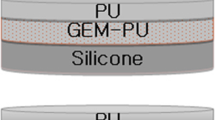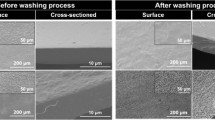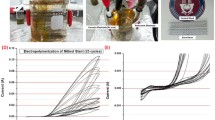Abstract
The purpose of the study was to evaluate the efficacy and safety of a developed drug delivery system containing OK-432 through in vitro and animal study. An OK-432-impregnated polycarbonate/polyurethane stent membrane was used to develop a drug delivery system (DDS) enabling the locoregional release of OK-432. Polyethyleneglycol was used as a detergent and porosity generator. The stability of OK-432 in solvent, releasing kinetics of drug, and cytotoxicity of the DDS were evaluated. OK-432-impregnated DDS was implanted in mice in which a human adenocarcinoma cell line was injected and grown in their back. Flow cytometry and enzyme-linked immunosorbent assay were used for quantifying the amount of drug. OK-432 exposed to phosphate-buffered saline and OK-432 exposed to N,N-dimethylacetamide showed similar results on dot graphs and histograms. However, OK-432 exposed to tetrahydrofurane showed different dot graphs and histograms, which means that the antigenicity of the drug was changed. The release rate of OK-432 was maintained at a constant level for 6 weeks. The local delivery of OK-432 was found to have an antitumor effect on a human adenocarcinoma cell line in an animal study, but no effect on this cell line in in vitro cell culture. Histologic examination showed minimal inflammatory reaction in surrounding tissue. Our study shows that local treatment using this OK-432 release system is safe and effective in reducing adenocarcinoma in a mouse model.







Similar content being viewed by others
References
Mezawa S, Homma H, Sato T, et al. (2000) A study of carboplatin-coated tube for the unresectable cholangiocarcinoma. Hepatology 32:916–923
Uehara K, Ichida T, Sugahara S, et al. (2002) Systemic administration of liposome-encapsulated OK-432 prolongs the survival of rats with hepatocellular carcinoma through the induction of IFN-gamma-producing hepatic lymphocytes. J Gastroenterol Hepatol 17:81–90
Okamoto M, Oshikawa T, Tano T, et al. (2003) Involvement of Toll-like receptor 4 signaling in interferon-gamma production and antitumor effect by streptococcal agent OK-432. J Natl Cancer Inst 95:316–326
Nose M, Uzawa A, Ogyu T, et al. (2001) OK-432 reduces mortality and bacterial translocation in irradiated and granulocyte-colony stimulating factor (G-CSF)-treated mice. J Radiat Res (Tokyo) 42:191–200
Nakahara S, Tsunoda T, Baba T, et al. (2003) Dendritic cells stimulated with a bacterial product, OK-432, efficiently induce cytotoxic T lymphocytes specific to tumor rejection peptide. Cancer Res 63:4112–4118
Takahashi K, Harauchi D, Kimura S, et al. (1998) OK-432 develops CTL and LAK activity in mononuclear cells from regional lymph nodes of lung cancer patients. Int J Immunopharmacol 20:375–388
Oshikawa T, Okamoto M, Ohe G, et al. (2003) Anti-tumor immune response induced by the fractions derived from OK-432, a streptococcal preparation, by using a monoclonal antibody TS-2 that neutralizes the interferon-gamma-inducing activity of OK-432: comparison between the TS-2-binding and TS-2-unbinding fraction. Int Immunopharmacol 3:643–655
Nishikido M, Kiyohara T, Koga S, et al. (2001) OK432-induced killer cell activity: potential method for monitoring immunological complications after renal transplantation. Nephrol Dial Transplant 16:2067–2071
Itoh T, Ueda Y, Okugawa K, Fujiwara H, et al. (2003) Streptococcal preparation OK432 promotes functional maturation of human monocyte-derived dendritic cells. Cancer Immunol Immunother 52:207–214
Shih CM, Shih CC, Su YY, et al. (2005) In vitro study of drug loading on polymer-free oxide films of metallic implants. J Biomed Mater Res A 75(3): 519–529
Gershlick AH (2005) Drug eluting stents in 2005. Heart 91(Suppl 3):iii24–iii31
Machan L, Burt HM, Hunter WL (1997) Local delivery of chemotherapy: a supplement to existing cancer treatments. A case for surgical pastes and coated stents. Adv Drug Deliv Rev 26:199–207
Jung GS, Song HY, Kang SG, et al. (2000) Malignant gastroduodenal obstructions: treatment by means of a covered expandable metallic stent-initial experience. Radiology 216:758–763
Monson JR, Donohue JH, McIlrath DC, et al. (1991) Total gastrectomy for advanced cancer. A worthwhile palliative procedure. Cancer 68:1863–1868
Meijer S, De Bakker OJ, Hoitsma HF (1983) Palliative resection in gastric cancer. J Surg Oncol 23:77–80
Kikuchi S, Tsutsumi O, Kobayashi N, et al. (1999) Does gastrojejunostomy for unresectable cancer of the gastric antrum offer satisfactory palliation? Hepatogastroenterology 46:584–587
Baron TH (2001) Expandable metal stents for the treatment of cancerous obstruction of the gastrointestinal tract. N Engl J Med 344:1681–1687
Pinto IT (1997) Malignant gastric and duodenal stenosis: palliation by peroral implantation of a self-expanding metallic stent. Cardiovasc Intervent Radiol 20:431–434
Feretis C, Benakis P, Dimopoulos C, et al. (1997) Duodenal obstruction caused by pancreatic head carcinoma: Palliation with self-expandable endoprostheses. Gastrointest Endosc 46:161–165
Song HY, Choi KC, Kwon HC, et al. (1992) Esophageal strictures: treatment with a new design of modified Gianturco stent. Work in progress. Radiology 184:729–734
Song HY, Yang DH, Kuh JH, et al. (1993) Obstructing cancer of the gastric antrum: palliative treatment with covered metallic stents. Radiology 187:357–358
Tatsugami K, Tamada K, Abe K, et al. (2000) Local injections of OK432 can help the infiltration of adoptively transferred CD8+ T cells into the tumor sites and synergistically induce the local production of Th1-type cytokines and CXC3 chemokines. Cancer Immunol Immunother 49:361–368
Acknowledgment
This study was supported by Korea Science and Engineering foundation (KOSEF), through its 2000 basic science support program (R01-2000-000-00121-0).
Author information
Authors and Affiliations
Corresponding author
Rights and permissions
About this article
Cite this article
Lee, D.H., Kang, SG., Jeong, S. et al. Local Delivery System of Immune Modulating Drug for Unresectable Adenocarcinoma: In Vitro Experimental Study and In Vivo Animal Study. Cardiovasc Intervent Radiol 29, 832–837 (2006). https://doi.org/10.1007/s00270-005-0194-x
Published:
Issue Date:
DOI: https://doi.org/10.1007/s00270-005-0194-x




